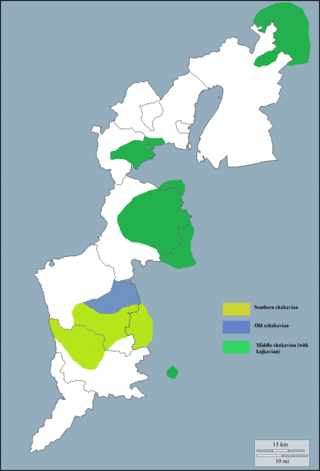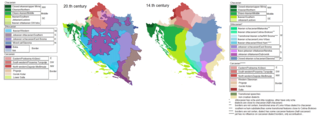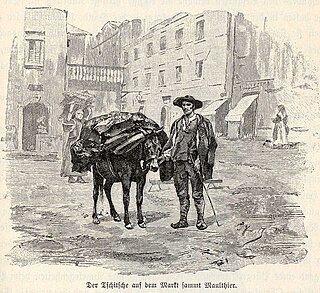Related Research Articles

Serbo-Croatian – also called Serbo-Croat, Serbo-Croat-Bosnian (SCB), Bosnian-Croatian-Serbian (BCS), and Bosnian-Croatian-Montenegrin-Serbian (BCMS) – is a South Slavic language and the primary language of Serbia, Croatia, Bosnia and Herzegovina, and Montenegro. It is a pluricentric language with four mutually intelligible standard varieties, namely Serbian, Croatian, Bosnian, and Montenegrin.

Slovene, or alternatively Slovenian, is a South Slavic language, a sub-branch that is part of the Balto-Slavic branch of the Indo-European language family. It is spoken by about 2.5 million speakers worldwide, mainly ethnic Slovenes, the majority of whom live in Slovenia, where it is the sole official language. As Slovenia is part of the European Union, Slovene is also one of its 24 official and working languages.

The South Slavic languages are one of three branches of the Slavic languages. There are approximately 30 million speakers, mainly in the Balkans. These are separated geographically from speakers of the other two Slavic branches by a belt of German, Hungarian and Romanian speakers.

Shtokavian or Štokavian is the prestige supradialect of the pluricentric Serbo-Croatian language and the basis of its Serbian, Croatian, Bosnian and Montenegrin standards. It is a part of the South Slavic dialect continuum. Its name comes from the form for the interrogative pronoun for "what" što. This is in contrast to Kajkavian and Chakavian.

Kajkavian is a South Slavic supradialect or language spoken primarily by Croats in much of Central Croatia and Gorski Kotar.

Chakavian or Čakavian is a South Slavic supradialect or language spoken by Croats along the Adriatic coast, in the historical regions of Dalmatia, Istria, Croatian Littoral and parts of coastal and southern Central Croatia, as well as by the Burgenland Croats as Burgenland Croatian in southeastern Austria, northwestern Hungary and southwestern Slovakia as well as few municipalities in southern Slovenia on the border with Croatia.

Burgenland Croatian is a regional variety of the Chakavian dialect of Croatian spoken in Austria, Hungary, the Czech Republic, and Slovakia. Burgenland Croatian is recognized as a minority language in the Austrian state of Burgenland, where it is spoken by 19,412 people according to official reports (2001). Many of the Burgenland Croatian speakers in Austria also live in Vienna and Graz, due to the process of urbanization, which is mostly driven by the poor economic situation of large parts of Burgenland.
Jakubinskij's law, or Meyer–Jakubinskij's law, is a sound law that operated in the Croatian Chakavian dialect in the 12th–13th century, named after Lav Jakubinski who discovered it in 1925, and sometimes also after K. H. Meyer who expanded and refined the rule in 1926.
Northern Chakavian is a dialect of the Chakavian variety of Croatian. It is spoken in eastern Istria, outskirts of Žminj and Pazin, Croatian Littoral up to Bakar, on the islands of Cres and northern Lošinj, north of Central Chakavian.
Southern Chakavian or Ikavian Chakavian is a dialect of the Chakavian variety of Croatian. It is spoken in the area south of the Central Chakavian area, in a narrow strip of Dalmatian littoral and the neighbouring islands: outskirts of Split and Zadar; Korčula, Pelješac, Brač, Hvar, Vis and Šolta. It is also present in the Northwestern part of Istria.
Central Chakavian is a dialect of the Chakavian variety of Croatian. It is spoken on the islands Dugi, Kornati, Lošinj, Krk, Rab, Ugljan Pag, on the land the cities of Vinodol, Ogulin, Brinje, Otočac, the area around Duga Resa, part of Central and Northeastern Istria, and Municipality of Kostanjevica na Krki in Slovenia.

Croatian is the standardised variety of the Serbo-Croatian pluricentric language mainly used by Croats. It is the national official language and literary standard of Croatia, one of official languages of Bosnia and Herzegovina, Montenegro, the Serbian province of Vojvodina, the European Union and a recognized minority language elsewhere in Serbia and other neighbouring countries.

The Dubrovnik subdialect is a subdialect of the Shtokavian dialect of Serbo-Croatian. It is spoken in the area of Dubrovnik and the littoral of the former Republic of Ragusa, from Janjina on the Pelješac peninsula to the Croatian border with Montenegro, island of Mljet.

The Eastern Herzegovinian dialect is the most widespread subdialect of the Shtokavian dialect of Serbo-Croatian, both by territory and the number of speakers. It is the dialectal basis for all modern literary Serbo-Croatian standards: Bosnian, Croatian, Serbian, and Montenegrin.
The Čičarija dialect is a Slovene dialect in the Littoral dialect group. It is spoken in a few villages in Slovenian Istria near the Croatian border in the Čičarija region in the villages of Skadanščina, Golac, Obrov, Podbeže, Podgrad, Poljane, Račice and Starod. By number of speakers, it is one of the smallest Slovene dialects.

Younger Ikavian, also called Western Ikavian/Western Neoshtokavian Ikavian, or Bosnian–Dalmatian dialect, and Bunjevac dialect, is a subdialect of Shtokavian Serbo-Croatian spoken in Croatia in the Dalmatian Hinterland, in Bosnia and Herzegovina west of the river Bosna and Neretva, and in the Bácska region of Hungary and the autonomous province Vojvodina of Serbia. Most speakers use the Latin alphabet.

The dialects of Serbo-Croatian include the vernacular forms and stadardized sub-dialect forms of Serbo-Croatian as a whole or as part of its standard varieties: Bosnian, Croatian, Montenegrin, and Serbian. They are part of the dialect continuum of South Slavic languages that joins the Macedonian dialects to the south, Bulgarian dialects to the southeast and Slovene dialects to the northwest.

Mijo Lončarić was a Croatian linguist.

Ćić, is an ethnonym and exonym in a broader sense for all the people who live in the mountainous Ćićarija area in Croatia and Slovenia. Alongside the term Ćiribirci, in the narrow sense, it is an exonym referring to a community of the Istro-Romanians in the village Žejane in a small part of eastern Ćićarija and the villages around the former Lake Čepić west of the Učka range in Istria, Croatia.
Southwestern Istrian, also known as Chakavian-Shtokavian, Shtokavian-Chakavian, or Shtakavian-Chakavian ikavian, is one of the dialects of the Chakavian language in Istria, Croatia. Through the history there were different hypothesis which classified it, besides in Chakavian, instead in Shtokavian, because it is a transitional dialect. It is the most widespread Chakavian dialect in Istria.
References
- Brozović, Dalibor (1988). Čakavsko narječje; Jezik srpskohrvatski / hrvatskosrpski, hrvatski ili srpski (in Serbo-Croatian). Zagreb: JLZ Miroslav Krleža. ISBN 953-0-30225-8.
- Lisac, Josip (2009). Hrvatska Dijalektologija 2. Čakavsko narječje[Croatian Dialectology 2: Chakavian dialect] (in Croatian). Zagreb: Golden Marketing-Tehnička knjiga. pp. 35–50. ISBN 9789532121698.
- Lončarić, Mijo (2021). "Buzetski dijalekt i kajkavština". Kaj (in Croatian). 54 (250) (3–4): 77–84. doi: 10.32004/k.54.3-4.3 . S2CID 248718149.
- Vivoda, Nataša (2005). Buzetski govori (in Slovenian). Koper: Univerza na Primorskem, Znanstveno-raziskovalno središče, Založba Annales. ISBN 961-6033-65-4.